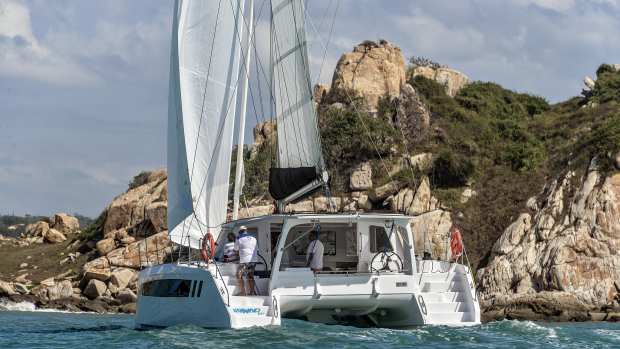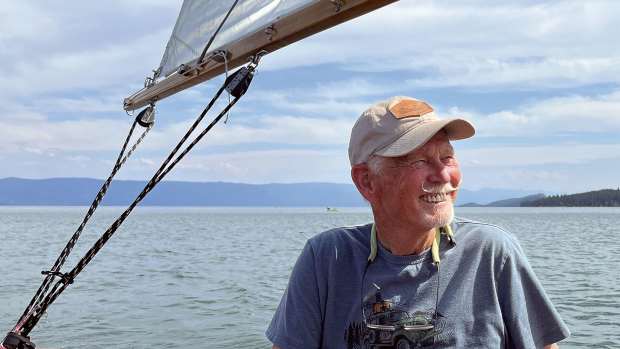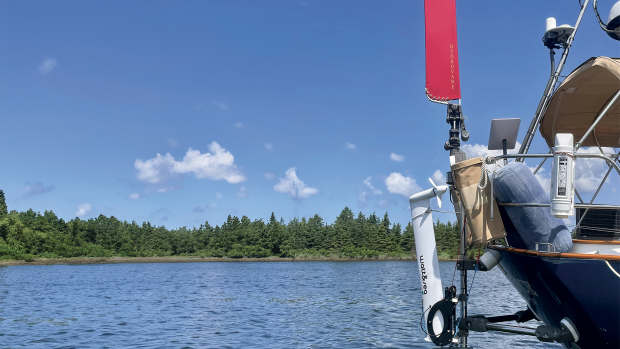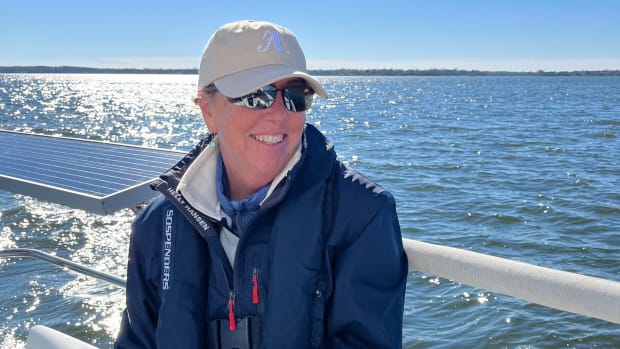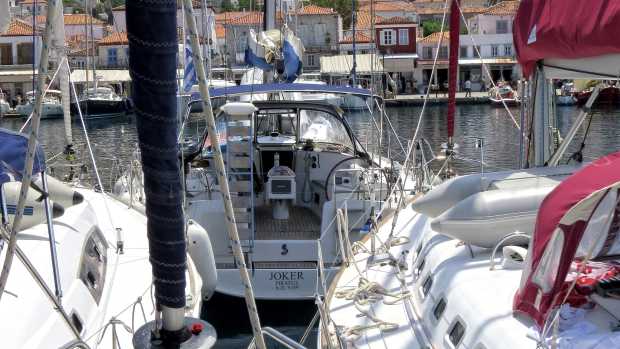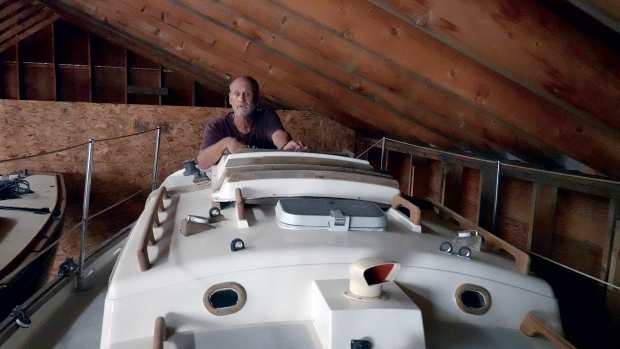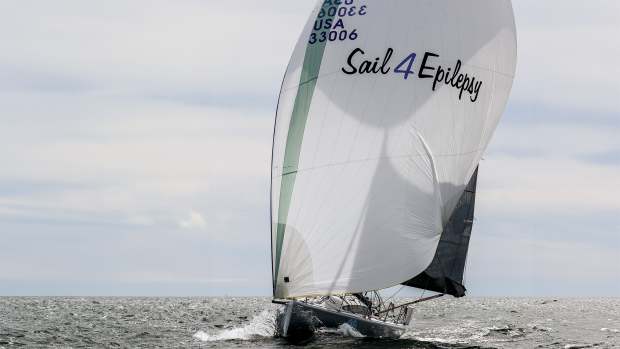Boat Review: Beneteau Oceanis 37.1
I could feel the boat find her groove and settle in at 7.2 knots on a beam reach with the code zero flying. It was a crisp autumn day on Chesapeake Bay and we were hauling the mail with one finger on the wheel and twin rudders gripping below the waterline. This was the kind of sailing I could do all day.
Our test boat was hull No. 3 of the Beneteau Oceanis 37.1, the newest model and the seventh in the Oceanis “.1” line. It replaces the very popular 38.1 of which 900 hulls were launched, so she has big shoes to fill. The from-scratch new hull slots perfectly into the line, which now includes models ranging from 31.1 to 51.1.
Designer Marc Lombard was tasked with delivering better performance and more interior volume in the last of the .1 line to be revamped. That’s a classic tradeoff, but Lombard succeeded by adding a hard chine that runs all the way forward where it terminates at the plumb bow, which also clears the waterline for tighter maneuvers. The broad forward section creates a spacious master suite below (more on that later). Meanwhile, the First Line version of the model that includes a 108% genoa and a traditional-hoist, square-top main also adds 22% to the sail area, making this one slippery boat.
Built in France, the newest family member sports a fractional Seldén rig, a rigid vang, and no backstay. A composite bowsprit holds the anchor and the attach point for a code zero which, when combined with the standard self-tacking jib and in-mast furling mainsail, makes a perfect shorthanded sail configuration. All lines run aft across the deck to four Harken winches and Spinlock stoppers, and the German-style mainsheet is a bridle with no traveler. There are two keel options—5 feet 4 inches and 6 feet 11 inches. Ours was the shoal keel, but the boat still pointed up to 40 degrees apparent wind angle and held on to her speed near 7 knots in 15 knots of wind across the deck.
The lack of backstays frustrated my sailing partners who were itching to play with sail shape during our test sail. But this boat’s goal is to provide spirited, easy sailing, and it accomplishes this extremely well.

An aft-facing nav station with all ship’s controls is next to the dining/lounging settee.
Photo: Beneteau
Twin wheels met me at the transom with a full binnacle to starboard and just a round handrail to port. The cockpit, which is more than 9 feet long, is well laid out and very comfortable with extra-wide bench seats and an enormous drop-leaf table that makes a great bracing point when heeling.
I found some features at the helms that were less to my liking. First, the throttle is at knee level which isn’t ideal when docking but is necessary when building a boat with cable, rather than electric, steering. Also down low is the Yanmar engine screen, which made it difficult to read the rpm. On the console, we had a 7-inch Raymarine display that probably could have been moved inboard to the wider portion of the binnacle and upgraded to a larger size. Lastly, the autopilot was on the port side although there was room for it on starboard nearer the throttle, and that’s odd placement in my opinion. The genoa sheets are led aft and within reach of the wheel, but the winches here are a bit tight with the binnacle to swing a proper handle and not hit your elbow.
All that said, the Sleipner bow thruster is properly placed and easy to operate, the wheel is light and responsive, there are impressively large chocks that reduce the strain at the aft cleats, and there is room enough at the drop-down transom to seat six people across without anyone feeling crowded.
The helm seats swing up and out providing wide and convenient access to the water. One other notable feature in the cockpit is the use of Iroko, an alternative to teak that’s created with the Iro-Deck process of laminated layers that are stronger, more uniform in color, and have a higher rot resistance than traditional decking. Not only is this a better solution, it helps ease the depletion of teak wood around the world.

The bright, voluminous salon includes a linear galley, with a dining table taken from a 40-foot model.
Photo: Beneteau
Below, the Oceanis 37.1 is generous with space and puts her 12 feet 10 inches of beam to good use. The straight-line galley is to starboard with a two-burner cooktop, a top- and side-loading fridge, and a single stainless steel sink. The cutting board is tucked into a holder near the trash bin, which could be iffy placement given the dirt in the area, and it won’t be easy to cook or wash dishes on a starboard tack. However, this layout gives the perception of length and room inside and that’s worth a lot. A U-shaped settee is to port with an enormous table borrowed from the 40.1. Also added is an aft-facing nav desk and comprehensive command center including the VHF radio, Fusion stereo, an inverter, and Ship Control, which is Beneteau’s Scheiber-based digital switching platform.
Aft are either one or two cabins. The U.S. market will likely lean toward a single cabin on port with a king-sized bed and a larger head to starboard with an enormous shower that also provides interior access to the massive storage room under the starboard cockpit settee. Headroom is 6 feet 3 inches throughout, so tall sailors rejoice.
The star of the show is the master stateroom forward with a queen-sized bed, plenty of locker space, multiple overhead hatches, and standing room for changing even with the door closed. This cabin was made possible by the wide bow and hard chine. You can shoehorn a second head in here, but I can’t see the point of ruining a welcoming stateroom with that.
Our boat was clad in walnut Alpi wood, which is a nod to traditional tastes, but a lighter oak color is also available. Indirect lighting combined with hull and deck windows as well as overhead hatches make this boat bright and inviting.
The 40-hp Yanmar is tucked under the four companionway steps. Access to the water pump, dipstick, and strainers is fairly good via side panels and the front of the engine compartment. With a three-bladed fixed propeller on the saildrive, we motored at 8.2 knots and 3,100 rpm at wide open throttle. That last knot will cost you at the fuel dock so it’s best to cruise at 7.3 knots and 2,400 rpm. Environmentally minded boaters have an option to spec a 12kW electric pod drive with a bank of lithium batteries and a range up to 10 miles at 5 knots.
As tested with a furling main, a genoa, air conditioning, an inverter, and the standard diesel, our test boat, which heralded the U.S. premier of the design, came in at $370,000.
Our day was made of the kind of spirited sailing you put to music on Instagram to make everyone jealous, and I really could have done it all day. Unfortunately, we had to hand off the boat after a couple of hours, but that was enough time to learn that the Oceanis 37.1 is a worthy successor to her predecessor, and we’ll just have to see if she cracks the record of 900 launched hulls in the years to come.
LOA/LWL 39’2” 35’6
Beam 12’10”
Draft 5’4” (shoal) 6’11”
Air Draft 54’6”
Displacement 15,128 lbs
Ballast 4,342 lbs (shoal)
Sail Area 646 sq ft upwind
Power 40 hp Yanmar with saildrive
Designer Marc Lombard
Builder Beneteau beneteau.com
Price $370,000 as tested
March 2024




